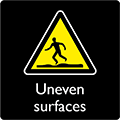Free Entry
Open any reasonable time during daylight hours
Address:
Butt Lane, Burgh Castle , Great Yarmouth, Norfolk, NR31 9QB
The late 3rd century 'Saxon Shore' fort at Burgh Castle was built as part of the Roman network of coastal defences, and probably abandoned just over a hundred years later. Three of its imposing stone walls survive, almost to their original height, making this one of the best preserved Roman monuments in Britain. The fourth wall collapsed into the surrounding marshes a long time ago.
The land around the fort is a wildlife haven and offers panoramic views over Breydon Water.
Managed by Norfolk Archaeological Trust - visit their website for more information on Burgh Castle Roman Fort and other sites in their care.
Read more about Burgh Castle Roman Fort's history.
Before You Go




Parking: There is a car and coach park on Butts Lane. Sat Nav: NR31 9QB. Car park charges are £1.50 for 2 hours, £2 for 4 hours or £4 all day (the car park is not owned or managed by English Heritage so Members need to pay the charge). For any car parking enquiries please contact Napier Parking. Please use the car park rather than parking on the surrounding narrow village roads, some of which have no pavement. The revenue from the car park is used by Norfolk Archaeological Trust to care for the fort site.
NB. Please note that the car park is opened at 8 a.m. and locked at 8 p.m. daily.
Access: It is possible to visit the fort on foot from dawn to dusk. There is a circular all-weather path around it which is accessible to those with limited mobility, including wheelchair users. For more information, download a map.
Facilities: There are no toilet or other facilities at the site itself. The site is in an exposed location but there are two small open-sided structures in the car park area, housing interpretation panels, which offer some shelter from bad weather. Sometimes there are displays in the village church. The Burgh Castle village pub (the Queen's Head) is nearby, at the junction of Church Road and Back Lane.
Dogs: Dogs on leads are welcome. Please clear up after your dog – there are dog waste bins at the fort.
Guided Tours: Discover the fascinating past of this fort site at one of the free one-hour guided tours that run every Sunday from May to September at 2 p.m., weather permitting. Meet a volunteer guide at the interpretation shelter near the main car park, and learn how this site became a place for defence and shelter for nearly 2,000 years. Book here
Guidebook: The Norfolk Archaeological Trust's guidebook to the site and the other Norfolk Saxon Shore forts is available from local shops or by visiting here to buy online.
Printable guide: There is a printable pdf guide that can be downloaded.
Please be aware: Climbing on the ruins is prohibited.
Drone flying: Please follow our Drone guidance
Plan a Great Day Out
If you enjoy walking, why not follow some of Angles Way, a long-distance path from Great Yarmouth to Thetford, which goes through the fort site? The section from Great Yarmouth to Burgh Castle Roman Fort is a lovely walk of about 4 miles along the southern shore of Breydon Water.
If you're looking for things to do in the area, just over four miles away you'll find the delightful Great Yarmouth Row House and Greyfriars' Cloisters. The Row Houses are two rare survivors of the town's original distinctive 'Rows', a crowded network of alleyways linking Yarmouth's three main thoroughfares. These unique and vividly presented houses both show life as it would have been at various stages of their histories, and are a real treasure trove for lovers of period decoration. Nearby Greyfriars' Cloisters, the remains of a 13th-century Franciscan friary, later converted into a number of Row dwellings, are also worth seeing.
Your Places Appeal
Did you know over 300 of our historic sites are free to explore and enjoy, but keeping them open and cared for costs more than £4.2 million every year?
With your help, we can protect these historic places and make sure they can be enjoyed for generations to come.
Whether your donation today helps pay for the work of an expert stonemason, a key keeper’s time to unlock the gates or the restoration of a rare artefact, you’ll help care for precious heritage.
Donate today